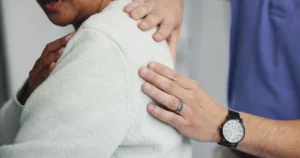Struggling with elbow pain and curious about PRP injections? PRP, or Platelet-Rich Plasma, injections utilize your body’s own healing mechanisms to repair and rejuvenate damaged tissues. In this post, we’ll discuss how PRP injections for elbow conditions have various treatments, their potential benefits, and the procedure involved.
Key Takeaways
- PRP (Platelet-Rich Plasma) injections leverage the body’s natural growth factors to promote healing and reduce pain in elbow conditions, offering a safer alternative to traditional treatments like corticosteroid injections.
- The administration of PRP involves drawing blood, centrifuging to concentrate platelets, and using ultrasound guidance to inject the PRP into the injured area, which can be done in under an hour in a doctor’s office.
- PRP therapy is effective for a variety of elbow conditions such as tennis elbow, golfer’s elbow, and chronic tendinosis, and generally involves a recovery period with initial discomfort and gradual pain relief over several weeks to months.
Understanding PRP Injections for Elbow Pain
Regenerative medicine includes treatments like PRP therapy. It harnesses the natural growth factors in blood cells to promote healing in damaged tissue. The procedure harnesses the patient’s natural healing process and proteins, known as growth factors, found in platelet-rich plasma to repair injured tissue. Tapping into the body’s own resources to reduce pain and expedite healing, this innovative approach presents an appealing solution for chronic elbow pain sufferers.
The growing popularity of PRP injections as a tennis elbow treatment stems from the existence of stubborn, long-term cases and the limitations of steroid injections. These factors have led to an upsurge in the application of PRP injections. Tennis elbow is a common yet challenging condition that leads patients to explore various treatment options. Research shows PRP’s effectiveness in treating conditions such as tennis elbow, offering a ray of hope for those grappling with continuous tennis elbow pain.
Further, PRP injections, being derived from the patient’s own blood, pose minimal risk of side effects and complications. This presents a notable advantage compared to traditional treatments, such as corticosteroid injections, known for their potential side effects. PRP employs concentrated platelets extracted from the patient’s own blood, constituting a natural and safe pathway to pain relief and healing.
How PRP Injections Are Administered
The process of administering PRP injections includes the following steps:
- Drawing a small amount of blood from the patient.
- Placing the blood in a centrifuge, a device that spins at high speed to separate the blood into its various components.
- Separating red blood cells from plasma and platelets using the centrifuge.
- Obtaining a mixture with a high concentration of platelets.
Once the platelets and plasma are isolated, the concentrated mixture is prepared for platelet rich plasma injections. PRP injections for orthopedic conditions should always be performed in an orthopedic surgeon’s office and the procedure takes less than an hour. This quick and convenient process can often be done within a single visit, making it accessible for many patients.
To ensure the PRP is injected into the precise area of injury, the procedure may be done with ultrasound guidance. This technology helps the physician accurately place the injection, maximizing the treatment’s effectiveness. The injection site is then carefully monitored to ensure the PRP is working as intended, initiating the body’s natural healing process.
The Science Behind PRP Therapy
At the heart of platelet rich plasma PRP therapy lies the concentration of platelets, white blood cells, and growth factors in the injured area, a process that stimulates tissue regeneration, curbs inflammation, and amplifies the body’s innate healing mechanism. Platelet-rich plasma consists of plasma and platelets, which play a crucial role in healing by triggering cell reproduction and stimulating tissue regeneration. Plasma is the liquid portion of whole blood, composed largely of water and proteins, while platelets are blood cells that cause blood clots and have necessary growth and healing functions. With platelet rich plasma therapy, patients can experience a more efficient recovery process.
Upon injecting PRP into the injured area, the concentrated platelets emit growth factors. These factors stimulate the production of reparative cells in the body, thereby augmenting the healing process. This increase in growth factors helps accelerate the healing process, reduce pain, and promote tissue regeneration. The exact mechanism of PRP injections is not completely understood, but the results have shown promising outcomes.
Also, PRP’s anti-inflammatory effects can help bolster the body’s natural recovery processes and enhance the concentration of growth factors in the injured elbow. This two-pronged approach of inflammation reduction and healing promotion renders PRP therapy a potent instrument in regenerative medicine. PRP injections can stimulate the release of anti-inflammatory growth hormone, which in turn supports muscle regeneration. This process may help expedite the healing of tissues and muscles.
Conditions Treated with PRP Injections
PRP injections can address a range of elbow conditions, providing hope when other treatments have fallen short. Predominantly, these injections serve as a PRP treatment to treat tennis elbow symptoms by enhancing the body’s inherent capacity to repair and rejuvenate damaged tissue. Golfer’s elbow, or medial epicondylitis, a common condition characterized by overuse-induced damage to the wrist flexors on the inner elbow, can also be addressed with PRP injections.
In addition to these prominent conditions, PRP injections prove effective in treating olecranon bursitis, distal biceps tendon injuries, and cubital tunnel syndrome. These conditions, often resulting from overuse or injury, can significantly benefit from the regenerative properties of PRP therapy.
Chronic elbow tendinosis, a persistent and often debilitating condition, can also see marked improvement with PRP injections. By aiding in the repair of persistent tendinopathy, PRP provides a viable option for those suffering from long-term elbow issues.
PRP vs. Traditional Treatments
A comparison of PRP injections with traditional treatments such as corticosteroid injections reveals several key distinctions. Local corticosteroid injections may offer better outcomes in the short term for conditions like lateral elbow pain, also known as lateral epicondylitis. These injections can provide almost immediate relief from pain, but this relief is often short-lived, typically lasting between 2 to 6 weeks.
On the other hand, for the right patient candidates, PRP injections show superior pain and function improvements 24 weeks post-treatment compared to corticosteroid injections. The long-lasting benefits of PRP can make it a more sustainable option for those struggling with elbow pain. While steroid injections provide short-term relief, they often come with proven recurrence rates and complications, limiting their long-term use.
Furthermore, PRP injections come with fewer complications than corticosteroid injections, which can result in skin atrophy, discoloration, and tendon tears. PRP injections may also reduce or eliminate the need for opioids and anti-inflammatory medications, offering a safer alternative for long-term management of elbow pain.
The limitations and potential complications of corticosteroid injections make PRP a very promising treatment for patients seeking long-term relief. As a game changer in regenerative medicine, PRP injections can significantly improve function and reduce pain without the severe side effects associated with traditional treatments.
Recovery and Expectations Post-PRP Injection
Recovery after a PRP injection is a gradual process, and patients should anticipate some initial discomfort. Expect to experience more pain for 2-3 days after the PRP injection. This initial increase in pain is a normal part of the healing process as the body begins to repair the damaged tissue.
Patients may start to experience pain relief within 3-4 weeks after the first session. Significant improvements are typically seen around 6 weeks, with full recovery potentially taking 4 to 6 months. During this time, it’s vital to shun strenuous arm use and abstain from non-steroidal anti-inflammatory medications like ibuprofen for a minimum of 3 weeks post-injection. Physiotherapy can be resumed after 10 days following the PRP injection to aid in recovery.
The PRP procedure involves the following steps:
- The injection site will be covered with a shower-proof dressing, which can be removed the next day.
- A follow-up appointment is usually scheduled six weeks post-procedure to evaluate progress and ensure the healing process is on track.
- It may take several weeks for the benefits of the PRP procedure to become fully apparent.
Who is a Good Candidate for PRP Therapy?
PRP therapy isn’t suitable for everyone. Typically, individuals in overall good health without any chronic illnesses are eligible for PRP injections. However, those suffering from autoimmune disorders might not be suitable candidates as their immune system could respond adversely to the treatment. Furthermore, individuals with chronic liver disease may not be ideal candidates owing to compromised blood quality.
As the therapy relies on a high concentration of platelets, patients with a low platelet count are generally unsuitable for PRP injections. Those grappling with active infections in the elbow region should first resolve the infection before opting for PRP therapy. Similarly, individuals with bleeding or blood clotting disorders due to the injection process involved may encounter heightened risks with PRP therapy.
The severity of the elbow condition is also a key factor in determining suitability for PRP therapy. Moderate cases often benefit the most, especially if the patient has not responded adequately to conventional elbow treatments. Consulting with a healthcare provider can help determine if PRP therapy is the right choice for your specific condition.
Summary
In summary, PRP injections offer a revolutionary approach to treating elbow pain by utilizing the body’s natural healing processes. This therapy has shown promise in providing long-term relief for various elbow conditions. By concentrating growth factors in the injured area, PRP injections stimulate tissue regeneration and reduce inflammation, leading to improved function and reduced pain.
Considering the limitations and potential complications of traditional treatments like corticosteroid injections, PRP therapy stands out as a potentially safer and more effective option for long-term management of elbow pain. If you’re struggling with stubborn elbow conditions and seeking a solution that promotes healing from within, PRP injections might be the answer you’ve been looking for.
Frequently Asked Questions
What are PRP injections?
PRP injections use a concentration of platelets from your own blood to release growth factors and promote healing in damaged tissues.
How are PRP injections administered?
PRP injections are administered by drawing blood, separating platelets and plasma, and then injecting the concentrated mixture into the affected area, commonly with ultrasound guidance.
What conditions can PRP injections treat?
PRP injections can treat tennis elbow, golfer’s elbow, olecranon bursitis, distal biceps tendon injuries, and chronic elbow tendinosis.
How do PRP injections compare to traditional treatments?
PRP injections provide long-lasting benefits with fewer complications compared to corticosteroid injections, which offer short-term relief but have higher recurrence rates and potential side effects. Therefore, PRP injections may be a preferable option for some individuals.
Who is a good candidate for PRP therapy?
Generally, healthy individuals without chronic illnesses, autoimmune disorders, or bleeding disorders, and who have not responded well to conventional treatments are good candidates for PRP therapy. It is important to consider any existing medical conditions before considering this treatment.





